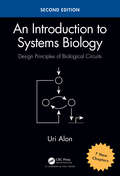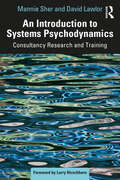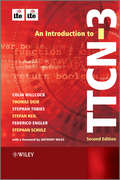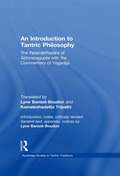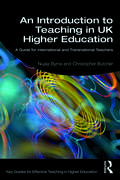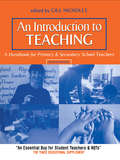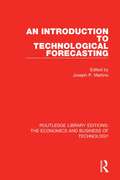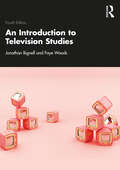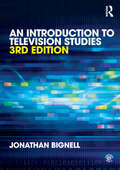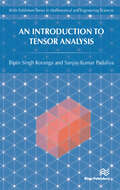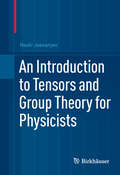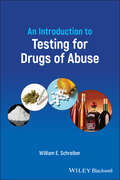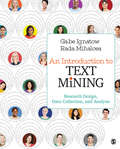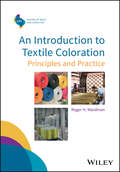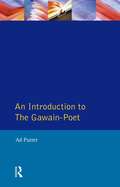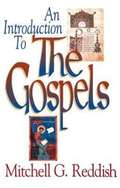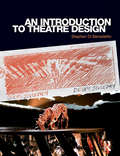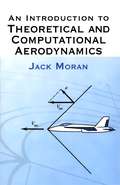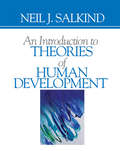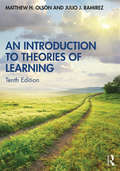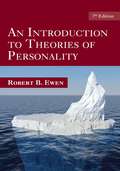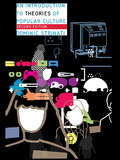- Table View
- List View
An Introduction to Systems Biology: Design Principles of Biological Circuits, Second Edition (Chapman & Hall/CRC Mathematical and Computational Biology)
by Uri AlonPraise for the first edition: … superb, beautifully written and organized work that takes an engineering approach to systems biology. Alon provides nicely written appendices to explain the basic mathematical and biological concepts clearly and succinctly without interfering with the main text. He starts with a mathematical description of transcriptional activation and then describes some basic transcription-network motifs (patterns) that can be combined to form larger networks. – Nature [This text deserves] serious attention from any quantitative scientist who hopes to learn about modern biology … It assumes no prior knowledge of or even interest in biology … One final aspect that must be mentioned is the wonderful set of exercises that accompany each chapter. … Alon’s book should become a standard part of the training of graduate students. – Physics Today Written for students and researchers, the second edition of this best-selling textbook continues to offer a clear presentation of design principles that govern the structure and behavior of biological systems. It highlights simple, recurring circuit elements that make up the regulation of cells and tissues. Rigorously classroom-tested, this edition includes new chapters on exciting advances made in the last decade. Features: Includes seven new chapters The new edition has 189 exercises, the previous edition had 66 Offers new examples relevant to human physiology and disease
An Introduction to Systems Psychodynamics: Consultancy Research and Training
by Mannie Sher David LawlorThis book provides an introduction to systems psychodynamic theory and its application to organisational consultancy, research and training, outlining systems dynamics methods and their historical and theoretical developments. Systems Psychodynamics is an emerging field of social science, the boundaries of which are continually being refined and re-defined. The ‘systems’ designation refers to open systems concepts that provide the framing perspective for understanding the structural aspects of organisational systems. These include its design, division of labour, levels of authority, and reporting relationships; the nature of work tasks, processes, and activities; its mission and primary task; and the nature and patterning of the organisation’s task and sentient boundaries and the transactions across them. This book presents a critical appraisal of the systems psychodynamics paradigm and its application to present-day social and organisational difficulties, showing how a holistic approach to organisational and social problems can offer a fresh perspective on difficult issues. Bringing together the theory and practice of systems psychodynamics for the first time, this book provides an examination of the systems psychodynamics paradigm in action. This book gives an accessible and thorough guide to understanding and using systems psychodynamic ideas for analysts, managers, policy makers, consultants and researchers in a wide range of professional and clinical settings.
An Introduction to TTCN-3
by Colin Willcock Thomas Deiß Stephan Tobies Federico Engler Anthony Wiles Stefan Keil Stephan SchulzThis unique book provides a fully revised and up-to-date treatment of the TTCN-3 language TTCN-3 is an internationally standardised test language with a powerful textual syntax which has established itself as a global, universal testing language. Application of TTCN-3 has been widened beyond telecommunication systems to areas such as the automotive industry, internet protocols, railway signalling, medical systems, and avionics.An Introduction to TTCN-3 gives a solid introduction to the TTCN-3 language and its uses, guiding readers though the TTCN-3 standards, methodologies and tools with examples and advice based on the authors' extensive real-world experience. All the important concepts and constructs of the language are explained in a step-by-step, tutorial style, and the authors relate the testing language to the overall test system implementation, giving the bigger picture.This second edition of the book has been updated and revised to cover the additions, changes and extensions to the TTCN-3 language since the first version was published. In addition, this book provides new material on the use of XML, test framework design and LTE testing with TTCN-3.Key Features:Provides a fully revised and up-to-date look at the TTCN-3 language Addresses language standardization, tool implementation and applying TTCN-3 in real world scenarios such as VoIP and LTE testing Explores recent advances such as TTCN-3 core language extensions on type parameterization, behavior types, real time and performance testing Introduces the use of ASN.1 and XML with TTCN-3 Written by experts in the field Includes an accompanying website containing code samples and links to the relevant standards documents (www.wiley.com/go/willcock_ttcn-3_2e) This book is an ideal reference for test engineers, software developers, and standards professionals. Graduate students studying telecommunications and software engineering will also find this book insightful.
An Introduction to Tantric Philosophy: The Paramarthasara of Abhinavagupta with the Commentary of Yogaraja (Routledge Studies in Tantric Traditions)
by Lyne Bansat-Boudon Kamalesha Datta TripathiThe Paramārthasāra, or ‘Essence of Ultimate Reality’, is a work of the Kashmirian polymath Abhinavagupta (tenth–eleventh centuries). It is a brief treatise in which the author outlines the doctrine of which he is a notable exponent, namely nondualistic Śaivism, which he designates in his works as the Trika, or ‘Triad’ of three principles: Śiva, Śakti and the embodied soul (nara). The main interest of the Paramārthasāra is not only that it serves as an introduction to the established doctrine of a tradition, but also advances the notion of jiv̄anmukti, ‘liberation in this life’, as its core theme. Further, it does not confine itself to an exposition of the doctrine as such but at times hints at a second sense lying beneath the evident sense, namely esoteric techniques and practices that are at the heart of the philosophical discourse. Its commentator, Yogarāja (eleventh century), excels in detecting and clarifying those various levels of meaning. An Introduction to Tantric Philosophy presents, along with a critically revised Sanskrit text, the first annotated English translation of both Abhinavagupta’s Paramārthasāra and Yogarāja’s commentary. This book will be of interest to Indologists, as well as to specialists and students of Religion, Tantric studies and Philosophy.
An Introduction to Teaching in UK Higher Education: A Guide for International and Transnational Teachers (Key Guides for Effective Teaching in Higher Education)
by Christopher Butcher Nuala ByrneCovering everything you need to know about teaching within the UK higher education system, this book is the ideal introduction for anyone looking to start their teaching career. A must-read guide for international staff new to teaching in UK higher education, this key text focuses on what is particular and often baffling to those who are new to higher education teaching in the UK. With practical tips and advice rooted in relevant theory, it is an invaluable resource to guide you through the initial teaching experience. Breaking down all of the aspects involved in teaching, learning and assessing in UK higher education, this book covers: The key features of UK higher education – particularly how it might differ from other systems How courses and the curriculum are designed How to support learning within your teaching practice Advice on marking and giving worthwhile feedback How to develop your own professional practice A full glossary of key terms An Introduction to Teaching in UK Higher Education is a one-stop resource for those looking to begin a career in UK higher education. Particularly useful for new international staff, it will also be of interest to those looking to improve their teaching practice.
An Introduction to Teaching: A Handbook for Primary and Secondary School Teachers
by Gill NichollsThe expectations of what it is to be a teacher are as high as ever. An Introduction to Teaching, which is the second edition of the well-established textbook Learning to Teach, provides a fully up-to-date introduction to the process and practice of teaching, and the personal and professional skills that successful teaching requires. This comprehensive update of the first edition is written in accordance with the Teacher Training Association and DfES guidelines, and provides in-depth coverage of all the modules included in the teacher training programme. Taking into account recent developments in policy and practice, contributors have incorporated new material covering teaching and classroom management, new approaches to planning, targeting effective learning, introduction to professional requirements and continuing professional development.The book also includes key chapters on the following: the National Curriculum children's learning the use of IT planning and preparation teaching and classroom management special educational needs working with parents.
An Introduction to Technological Forecasting (Routledge Library Editions: The Economics and Business of Technology #31)
by Joseph P. MartinoOriginally published in 1972 this book examines technological forecasting and assesses its merits and limitations and possible uses for society, government, industry and the military. Although technological forecasting was in its infancy when this book was originally published, it has now become part of mainstream social and economic planning.
An Introduction to Television Studies
by Jonathan Bignell Faye WoodsThis comprehensive textbook, now substantially updated for its fourth edition, provides students with a framework for understanding the key concepts and main approaches to Television Studies, including audiences, representation, industry and global television, as well as the analytical study of individual programmes. This new edition reflects the significant changes the television industry is undergoing in the streaming era with an explosion of new content and providers, whilst also identifying how many existing practices have endured. The book includes a glossary of key terms, with each chapter suggesting further reading. New and updated material includes: Chapters on style and form, narrative, industry, and representation and identity Case studies on Bon Appétit’s YouTube channel, Insecure, British youth television, ABC and Disney+, fixed-rig observational documentary, streaming platforms' use of data to shape audience experience, Chewing Gum, Korean drama and The Marvelous Mrs Maisel Sections on medical drama, YouTube creators, Skam and scripted format sales, the global spread of streaming platforms, prestige TV and period drama With individual chapters addressing television style and form, narrative, histories, industries, genres and formats, realities, production, audiences, representation and identity, and quality, this book is essential reading for both students and scholars of Television Studies.
An Introduction to Television Studies
by Jonathan BignellIn this comprehensive textbook, now updated for its third edition, Jonathan Bignell provides students with a framework for understanding the key concepts and main approaches to Television Studies, including audience research, television history and broadcasting policy, and the analytical study of individual programmes. Features include: a glossary of key terms key terms defined in margins suggestions for further reading activities/assignments for use in class New and updated case studies feature: ‘Every Home Needs a Harvey’ ad approaches to news reporting television scheduling CSI Crime Scene Investigation animated cartoon series Individual chapters address: studying television, television histories, television cultures, television texts and narratives, television genres and formats, television production, television and quality, television realities, television you can’t see, television audiences, beyond television.
An Introduction to Tensor Analysis
by Bipin Singh Koranga Sanjay Kumar PadaliyaThe subject of Tensor Analysis deals with the problem of the formulation of the relation between various entities in forms which remain invariant when we pass from one system of coordinates to another. The invariant form of equation is necessarily related to the possible system of coordinates with reference to which the equation remains invariant. The primary purpose of this book is the study of the invariance form of equation relative to the totally of the rectangular co-ordinate system in the three-dimensional Euclidean space. We start with the consideration of the way the sets representing various entities are transformed when we pass from one system of rectangular co-ordinates to another. A Tensor may be a physical entity that can be described as a Tensor only with respect to the manner of its representation by means of multi-sux sets associated with different system of axes such that the sets associated with different system of co-ordinate obey the transformation law for Tensor. We have employed sux notation for tensors of any order, we could also employ single letter such A,B to denote Tensors.
An Introduction to Tensors and Group Theory for Physicists
by Nadir JeevanjeeAn Introduction to Tensors and Group Theory for Physicists provides both an intuitive and rigorous approach to tensors and groups and their role in theoretical physics and applied mathematics. A particular aim is to demystify tensors and provide a unified framework for understanding them in the context of classical and quantum physics. Connecting the component formalism prevalent in physics calculations with the abstract but more conceptual formulation found in many mathematical texts, the work will be a welcome addition to the literature on tensors and group theory. Advanced undergraduate and graduate students in physics and applied mathematics will find clarity and insight into the subject in this textbook.
An Introduction to Testing for Drugs of Abuse
by William E. SchreiberAn Introduction to Testing for Drugs of Abuse An Introduction to Testing for Drugs of Abuse presents a distilled set of facts about the major drugs of abuse that are encountered in clinical practice. Individual chapters highlight the similarities in chemical structure, mechanism of action, and physiologic effects of each drug group, as well as their metabolism, therapeutic uses and potential for misuse or abuse. Special attention is given to the testing process, with an emphasis on interpretation of test results. Informative and entertaining cases appear at the end of each chapter. These cases illustrate the many situations in which drug testing is performed for medical, legal and employment purposes. Written in clear, concise language, this book provides practical guidance to pathologists, clinical chemists and technologists who are responsible for reporting and interpreting the results of drug analyses. It will be especially useful to residents and students who are learning about toxicology for the first time. Clinical practitioners – doctors, nurses, pharmacists and other health care professionals – will find the information they need to order and interpret drug tests accurately.
An Introduction to Text Mining: Research Design, Data Collection, and Analysis
by Gabe Ignatow Rada F. MihalceaThis is the ideal introduction for students seeking to collect and analyze textual data from online sources. It covers the most critical issues that they must take into consideration at all stages of their research projects.
An Introduction to Text Mining: Research Design, Data Collection, and Analysis
by Gabe Ignatow Rada F. MihalceaThis is the ideal introduction for students seeking to collect and analyze textual data from online sources. It covers the most critical issues that they must take into consideration at all stages of their research projects.
An Introduction to Textile Coloration: Principles and Practice
by Roger H. WardmanAn Introduction to Textile Coloration: Principles and Practice The Publications Committee of the Society of Dyers and Colourists (SDC) has been aware for some time of the need to produce a book at an introductory level aimed at personnel working in textile dyeing or printing companies as well as those interested in entering into the field. The SDC runs a course for dyehouse technicians leading to the award of its Textile Coloration Certificate and this book is intended to be helpful for candidates following the course. Additionally, it will be helpful for professionals in textile companies who do not have a strong scientific background, so that they may attain a better understanding of the chemical principles of colour application. Starting with the basic science underlying dyeing and printing processes, this comprehensive book explains the fundamentals of dye and pigment chemistry and the various application techniques and processes. It offers chapter coverage of the general chemistry related to textiles, textile fibres, chemistry of dyes and pigments, industrial coloration methods, textile printing, theoretical aspects of dyeing, the measurement of colour and fastness testing. Reference is made to developments that have taken place in the coloration industry in recent years, not least of which have been the challenges imposed by the drive towards environmentally-friendly processes and restrictions on the use of certain chemicals. An Introduction to Textile Coloration: Principles and Practice Covers atomic structure, chemical reactions, and acids, bases, and salts Explains the nature of fibre-forming polymers and the conversion of synthetic polymers into fibre filaments Educates on the classification of colorants and the commercial naming of dyes and pigments Introduces readers to the dye application processes and dyeing machinery Instructs on dye aggregation, factors affecting colour appearance, the principles of colour fastness testing, and more
An Introduction to The Gawain-Poet (Longman Medieval and Renaissance Library)
by Ad PutterThe late 14th century produced a crop of brilliant writers: Chaucer, Langland and Gower. Their achievement was rivalled only by a series of four works generally agreed to have been written by a single northern author, known as the Gawain-Poet. This book introduces the reader to the Gawain-poet's four surviving works: Sir Gawain and the Green Knight, Patience, Pearl and Cleanness. The four poems are made accessible to the student by setting them in their relevant historical and cultural context and by developing some lines of critical argument. All studies are based on the author's own research and translations.
An Introduction to The Gospels
by Mitchell G. ReddishAn Introduction to the Gospels is designed to be a textbook for courses on the Gospels, for use at the college and beginning seminary level. Reflecting the most recent scholarship and written in an accessible style, the volume covers all four of the Gospels, including a survey of "the world of the Gospels".The book opens with a discussion of the origin, development, and interrelationships of the Four Gospels. After a chapter-length treatment of each canonical Gospel and the non-canonical Gospels, the work concludes with a discussion of the "historical Jesus" debate.In An Introduction to the Gospels, Mitchell G. Reddish: - provides a solid, convenient survey of the Gospels in an accessible textbook format- presents up-to-date scholarship in a field that has been dominated by older texts- gives a balanced presentation of the content of the Gospels
An Introduction to Theatre Design
by Stephen Di BenedettoThis introduction to theatre design explains the theories, strategies, and tools of practical design work for the undergraduate student. Through its numerous illustrated case studies and analysis of key terms, students will build an understanding of the design process and be able to: identify the fundamentals of theatre design and scenography recognize the role of individual design areas such as scenery, costume, lighting and sound develop both conceptual and analytical thinking Communicate their own understanding of complex design work trace the traditions of stage design, from Sebastiano Serlio to Julie Taymor. Demonstrating the dynamics of good design through the work of influential designers, Stephen Di Benedetto also looks in depth at script analysis, stylistic considerations and the importance of collaboration to the designer's craft. This is an essential guide for students and teachers of theatre design. Readers will form not only a strong ability to explain and understand the process of design, but also the basic skills required to conceive and realise designs of their own.
An Introduction to Theoretical and Computational Aerodynamics (Dover Books on Aeronautical Engineering)
by Jack MoranThis concise and highly readable introduction to theoretical and computational aerodynamics integrates both classical and modern developments, focusing on applying methods to actual wing design. Designed for a junior- or senior-level course and as a resource for practicing engineers, it features 221 figures.
An Introduction to Theories of Human Development
by Neil J. Salkind"The book is well written and the theorists and their respective work are well-presented and clearly explained. . . . As a text dealing with the historical overview of major theorists and their work in human development over the last century or so, it is extremely strong and could be widely used in a variety of both undergraduate and graduate courses." —Ann C. Diver-Stamnes, Humboldt State University "In general, I found the websites and references listed at the end of each chapter to be very interesting and useful for taking students beyond what is in the text." —Jane Ledingham, University of Ottawa "A fine choice for a classic theories course, and I believe that the level of presentation would be appropriate for advanced undergraduate or graduate students. . . . The up-to-date web sites at the end of each section are a definite plus. The choice of sites is excellent." —Cosby Steele Rogers, Virginia Tech An Introduction to Theories of Human Development examines the development process, looking at the series of changes that occur as a result of an interaction between biological and environmental factors. Why might our behavior as an adult be so different from when we were infants? Why and how does one stage of development follow the next? Are the changes that we experience abrupt in nature or smooth and predictable? Author Neil J. Salkind reflects on such critical questions to help readers understand what happens along the way as one develops from infancy through later life. This book provides a comprehensive view of the primary theoretical models of human development including those from the biological, psychoanalytic, behavioral, and cognitive developmental perspectives. Along with a brief discussion of a historical background for each of these approaches, An Introduction to Theories of Human Development examines the application of these theories to various aspects of human development, such as the effectiveness of early intervention, individual differences, adolescence, and sociobiology. Features of this text: A final, integrative chapter compares the various theories presented in the book using Murry Sidman′s model of six criteria for judging a theory to help develop students′ skills for critically assessing theory. Classic approaches to understanding human behavior across the lifespan are also examined. Pedagogical features such as chapter opening quotes, boxed highlights, key terms, a glossary, and websites for further reading enhance student understanding of everyday human behavior.An Introduction to Theories of Human Development is an accessible text for advanced undergraduate students in the social and behavioral sciences including such fields as psychology, education, human services, nursing, sociology, social welfare, and human development and family studies.
An Introduction to Theories of Learning
by B. R. Hergenhahn Matthew H. OlsonDefines learning and shows how the learning process is studied. Clearly written and user-friendly, Introduction to the Theories of Learning places learning in its historical perspective and provides appreciation for the figures and theories that have shaped 100 years of learning theory research. The 9th edition has been updated with the most current research in the field. Learning Goals Upon completing this book, readers should be able to: Define learning and show how the learning process is studied Place learning theory in historical perspective Present essential features of the major theories of learning with implications for educational practice. <P><P><i>Advisory: Bookshare has learned that this book offers only partial accessibility. We have kept it in the collection because it is useful for some of our members. Benetech is actively working on projects to improve accessibility issues such as these.</i>
An Introduction to Theories of Learning
by Matthew H. Olson Julio J. RamirezSince its first edition, An Introduction to Theories of Learning has provided a uniquely sweeping review of the major learning theories from the 20th century that profoundly influenced the field of psychology. In this tenth edition, the authors present further experimental evidence that tests many of the fundamental ideas presented in these classic theories, as well as explore many of the advances in psychological science and neuroscience that have yielded greater insight into the processes that underlie learning in human beings and animals. The four main goals of this text are to define learning and to show how the learning process is studied (Chapters 1 and 2), to place learning theory in historical perspective (Chapter 3), and to present essential features of the major theories of learning with implications for educational practices (Chapters 4 through 16). The authors retained the best features of earlier editions while making revisions that reflect current research and scholarship, including coverage of active learning and the testing effect, information for problem solving in ravens, data illustrating the neurobiological basis of the cognitive map and spatial learning, new research on brain plasticity and its role in learning as well as the impact of poverty on brain and cognitive development, and new evidence that challenges the notion of learning styles. Complete with chapter summaries, discussion questions, glossary, and online resources for instructors, this text is essential reading for theories of learning and applied cognitive psychology courses.
An Introduction to Theories of Personality: 7th Edition
by Robert B. Ewen Robert Ewen BThis 7th Edition helps students unravel the mysteries of human behavior through its highly readable introduction to the ideas of the most significant personality theorists. Engaging biographical sketches begin each chapter, and unique capsule summaries help students review key concepts. Theories come alive through the inclusion of quotations from the theorists’ writings and numerous applications such as dream interpretation, psychopathology, and psychotherapy. Significant changes in the 7th edition include an extended discussion of the practical applications of personality theory, with an emphasis on guidelines that can help people increase their self-knowledge, make better decisions, and live more fulfilling lives. Fictionalized but true-to-life examples illustrating the perils of inadequate self-knowledge include college students, parents, terrorists, business executives, and politicians, while other examples show the positive outcomes that can result from a better understanding of one’s unconscious. This 7th edition also includes a more extensive discussion of how a lack of self-understanding caused difficulties for such noted theorists as Freud and Erikson, and a new section that explains how behavior can be strongly influenced by the situation as well as by one’s personality. Finally, a new interactive web site provides practice test questions and other topics of interest.
An Introduction to Theories of Popular Culture
by Dominic StrinatiAn Introduction to Theories of Popular Culture is widely recognized as an immensely useful textbook for students taking courses in the major theories of popular culture. Strinati provides a critical assessment of the ways in which these theories have tried to understand and evaluate popular culture in modern societies. Among the theories and ideas the book introduces are: mann culture, the Frankfurt School and the culture industry, semiology and structuralism, Marxism, feminism, postmodernism and cultural populism. This new edition provides fresh material on Marxism and feminism, while a new final chapter assesses the significance of the theories explained in the book.
An Introduction to Theory and Applications of Quantum Mechanics (Dover Books on Physics)
by Amnon YarivBased on a California Institute of Technology course, this outstanding introduction to formal quantum mechanics is geared toward advanced undergraduates in applied physics. The text addresses not only the basic formalism and related phenomena but also takes students a step further to a consideration of generic and important applications. The treatment's exploration of a wide range of topics culminates in two eminently practical subjects, the semiconductor transistor and the laser. Subjects include operators, Eigenvalue problems, the harmonic oscillator, angular momentum, matrix formulation of quantum mechanics, perturbation theory, the interaction of electromagnetic radiation with atomic systems, and absorption and dispersion of radiation in atomic media.Additional topics include laser oscillation, quantum statistics, applications of the statistical distribution laws, the interaction of electrons and nuclei with magnetic fields, and charge transport in semiconductors. Each chapter concludes with a set of problems.
